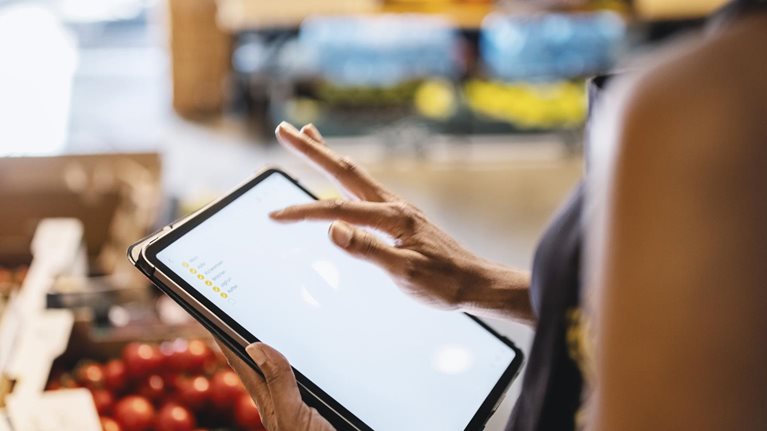The past year continued to reveal the ways in which the pandemic, evolving customer preferences for grocery, and macroeconomic trends have converged to reshape the traditional role of physical stores. As grocers seek to adapt, technology can streamline store operations—from checkout and talent management to merchandising and replenishment—and provide a better in-store environment for customers, all while helping to manage costs.
Stores under pressure
In many ways, the four-wall operating model for grocery has changed only incrementally over the past several decades. However, four primary forces will challenge long-held conventional wisdom and compel grocers to adapt.
Staffing shortages and rising labor costs. About one million roles remain open in the US retail industry, even with upgraded incentives and benefits such as year-end bonuses for in-store employees and tuition assistance.1 As fierce competition for retail store employees has pushed wages and benefit costs higher, grocers have responded by investing more in retention and upskilling efforts.
Increased stockouts. While omnichannel offerings have increased the complexity of supply chains, broader shifts in the economy have had a greater impact on operational resilience and cost structures. Logistics carriers continue to operate at reduced capacity, with a declining supply of container ships and overall capacity down by 11 percent from September 2020 to June 2021. These developments are further squeezing the industry’s already-tight margins. Our analysis shows that the pandemic’s impact on retailers could decrease EBITDA by 20 to 40 percent in the near term, with 15 to 20 percentage points of that decrease enduring if these supply chain shocks go unaddressed.
Fluctuating foot traffic. Lockdowns in the early phases of the pandemic resulted in a precipitous drop in foot traffic, but the grocery sector has rebounded. After vaccines became widely available to the public in spring 2021, foot traffic increased, even eclipsing prepandemic levels at times: for example, foot traffic was 7.6 percent higher in December 2021 compared with 2019.2 Superstores illustrated a similar trend in the latter half of the year, although the shopping week that included Thanksgiving and Black Friday was down 12.5 percent from 2019.
A shift from stores to e-commerce. While all these factors are putting added pressure on the role of stores, the capstone trend is that e-commerce has increasingly lured shoppers from traditional grocery stores. The move toward convenience and safety has fueled the rise of new delivery models, blurring the strict boundaries of the traditional store’s four walls. In the next five years, we estimate that 20 to 40 percent of grocery e-commerce volume could be fulfilled from alternative locations. Losing this volume will challenge the economics of many stores. Consumers who continue to shop in store are already seeking a different experience: self-checkout adoption has increased by almost 20 percent since the beginning of the COVID-19 pandemic, and 75 percent of respondents who have started or increased their use of self-checkout said they intend to continue.
Using in-store technology to improve customer experience and reset cost structures
In light of these challenges, 2022 will be a critical year for retailers to use technology to future-proof their physical stores. Many grocers and retailers have already experimented with tech-enabled customer experiences and store operations. The combination of increased pressure on margins and well-tested technologies means retailers have both the motivation and the opportunity to make sustained investments across a set of levers. According to our analysis, advanced tech-enabled checkout, talent management, merchandising and replenishment, and store environment maintenance can help the grocery industry create distinctive in-store experiences for customers and reduce costs by as much as 15 to 30 percent.
Self-checkout
Gone are the days when consumers were willing to wait in longer lines so that a cashier could weigh produce or bag groceries. Instead, customers increasingly value the safety, speed, and convenience offered by self-checkout, which can reduce friction for consumers and—crucially—free up employees for other operational tasks such as stocking and ad hoc customer assistance. When properly implemented, tech-enabled self-checkout can improve in-store productivity by 6 to 12 percent by reducing the labor hours required for operation.
Self-checkout is now table stakes for grocers, with future-facing checkout technologies such as mobile “scan and go” not far behind. Several retailers have already deployed mobile-scanning technology to help customers save time by checking out while they shop, thereby avoiding standing in line as well as unloading and reloading their carts. This real-time purchasing information also allows retailers to dynamically offer promotions and suggestions. At the same time, visual analytics, specifically AI and camera vision, can help address nagging issues such as shrinkage (loss of inventory through errors and theft) and help retailers use the analysis of visual data to improve process efficiency.
Talent management
The talent landscape has changed dramatically over the past two years. Retail positions were once considered highly desirable, offering flexible hours, product discounts, and other benefits. Now, other sectors offer the same—if not better—value proposition. In light of the current labor shortages, attracting workers requires far more than a “Now hiring” sign or an ad online. Employers must instead pursue a multipronged strategy: smarter and digitalized hiring, automated management to lighten the workload, and scaled efforts to train and retain employees.
These solutions can be useful at every step of the hiring journey. For instance, predictive analytics can help automate resume screening and reduce manual effort by 55 percent. When automatic screening is done well, store managers can spend more time on activities such as coaching and analysis that more directly improve store performance. These same analytical tools allow retailers to understand which candidate personas will help them succeed and to take early action to retain them.
Once hired, employees can benefit from digital training. One major retailer has made virtual-reality (VR) training available to associates and deployed gamified digital-training sessions to all US locations to build capabilities and drive engagement and retention.
Last, in our experience, AI-powered workforce planning and scheduling can save stores more than 10 percent in labor costs. These tools use AI to predict demand based on variables outside the store, such as traffic and weather patterns, and store-specific information. Retailers can use these insights to match staffing to each store’s needs while providing workers with the desired stability in scheduling.
Merchandising and replenishment
Inventory management, including counting products, identifying out-of-stock SKUs, and replenishing store shelves, accounts for a significant share of the in-store workload.
Grocers have been dabbling in robotics to manage these activities for the past several years, but two recent developments have changed the game. First, technology has evolved to allow robots to start to double-hat (that is, the same robot can manage stockout checks and cleaning), which strengthens the business cases for automation and makes investments more palatable. Second, retailers no longer have the labor resources to be able to cover all activities, so they must rely on automation to complete tasks. The use of robotics for tasks that are especially difficult or labor intensive, such as price tag validation, can support sales by improving in-stock rates and pricing and monitoring planogram compliance. In one pilot, robots detected 14 times the addressable out-of-stock situations compared with manual scans, reducing out-of-stock facings by 20 to 30 percent.3
Maintenance and store environment
To maintain more prevalent in-store technology and equipment, grocers can automate monitoring and enable predictive maintenance. These tech-enabled tools serve a dual purpose: they help to minimize the labor required to do routine maintenance checks, and they increase food safety in grocery environments by automating tasks previously open to human error. By embedding Internet of Things (IoT) sensors throughout the store’s tech and standard equipment (such as coolers and freezers), organizations can remotely detect and even predict maintenance events and then deploy remote support or shared-service teams to address an issue before it disrupts store operations. An IoT-enabled approach reduces the time store teams spend on not only monitoring in-store tech and equipment but also troubleshooting and coordinating support. Collectively, these efforts can boost the productivity of store teams by 1.5 percent, a significant amount when launched across the whole store fleet. Further, using automatic temperature monitors that send alerts when temperatures are outside of acceptable range—for example, in freezers and at prepared food stations—increases overall food safety and minimizes time spent on manual data collection.
Investments in technology used to feel optional for grocers—an opportunity to experiment or increase the “wow factor” in stores rather than to support mission-critical operations. Today, a wide range of affordable, field-tested technologies can help retailers reduce the cost structure of their stores while delivering a better experience for both consumers and employees. Audacious investments should be the next step for the industry.
Download the full report here.

